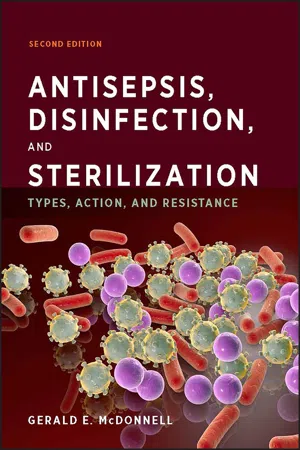
Antisepsis, Disinfection, and Sterilization
Types, Action, and Resistance
- English
- ePUB (mobile friendly)
- Available on iOS & Android
About this book
Antisepsis, Disinfection, and Sterilization: Types, Action, and Resistance, by Gerald E. McDonnell, is a detailed and accessible presentation of the current methods of microbial control. Each major category, such as physical disinfection methods, is given a chapter, in which theory, spectrum of activity, advantages, disadvantages, and modes of action of the methods are thoroughly and clearly presented. Sufficient background on the life cycles and general anatomy of microorganisms is provided so that the reader who is new to microbiology will better appreciate how physical and chemical biocides work their magic on microbes. Other topics in the book include:
- Evaluating the efficacy of chemical antiseptics and disinfectants, and of physical methods of microbial control and sterilization.
- Understanding how to choose the proper biocidal product and process for specific applications.
- Classic physical and chemical disinfection methods, such as heat, cold, non-ionizing radiation, acids, oxidizing agents, and metals.
- Newer chemical disinfectants, including, isothiazolones, micro-and nano-particles, and bacteriophages as control agents.
- Antisepsis of skin and wounds and the biocides that can be used as antiseptics.
- Classic methods of physical sterilization, such as, moist heat and dry heat sterilization, ionizing radiation, and filtration, along with newer methods, including, the use of plasma or pulsed light.
- Chemical sterilization methods that use ethylene oxide, formaldehyde, or a variety of other oxidizing agents.
- A detailed look at the modes of action of biocides in controlling microbial growth and disrupting microbial physiology.
- Mechanisms that microorganisms use to resist the effects of biocides.
The second edition of Antisepsis, Disinfection, and Sterilization: Types, Action, and Resistance is well suited as a textbook and is outstanding as a reference book for facilities managers and application engineers in manufacturing plants, hospitals, and food production facilities. It is also essential for public health officials, healthcare professionals, and infection control practitioners.
Frequently asked questions
- Essential is ideal for learners and professionals who enjoy exploring a wide range of subjects. Access the Essential Library with 800,000+ trusted titles and best-sellers across business, personal growth, and the humanities. Includes unlimited reading time and Standard Read Aloud voice.
- Complete: Perfect for advanced learners and researchers needing full, unrestricted access. Unlock 1.4M+ books across hundreds of subjects, including academic and specialized titles. The Complete Plan also includes advanced features like Premium Read Aloud and Research Assistant.
Please note we cannot support devices running on iOS 13 and Android 7 or earlier. Learn more about using the app.
Information
1
INTRODUCTION
1.1 GENERAL INTRODUCTION
- Activity against a wide range of (if not all) microorganisms
- Rapid activity
- Efficacy in the presence of contaminating organic and inorganic materials, which can inhibit the activity of the biocide
- Low or no toxicity, irritancy, mutagenicity (causing genetic mutations), or carcinogenicity (causing cancer)
- Safe use
- Lack of damage to surfaces or areas (compatibility)
- Lack of unwanted or toxic residues
- Stability, yet ability to be readily broken down in the environment
- Environmental friendliness
Table of contents
- Cover
- Table of Contents
- Title Page
- Copyright
- ACKNOWLEDGMENTS
- PREFACE
- ABOUT THE AUTHOR
- 1 INTRODUCTION
- 2 PHYSICAL DISINFECTION
- 3 CHEMICAL DISINFECTION
- 4 ANTISEPTICS AND ANTISEPSIS
- 5 PHYSICAL STERILIZATION
- 6 CHEMICAL STERILIZATION
- 7 MECHANISMS OF ACTION
- 8 MECHANISMS OF MICROBIAL RESISTANCE
- INDEX
- End User License Agreement